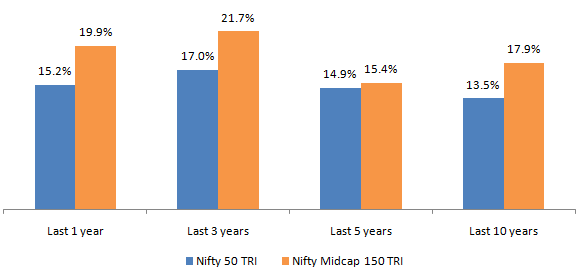Mid Cap Investing

Midcap cap funds have been among the top performing equity mutual fund categories in the last one year1. In the last one year, Nifty Midcap 150 TRI gave 20% return versus Nifty 50 TRI return of 15%2. Midcap funds are equity mutual fund schemes which primarily invest in midsized companies listed on stock exchanges.
As per SEBI, 101st to 250th companies by market capitalization are classified as midcap companies. SEBI mandates midcap funds to invest at least 65% of their assets in midcap stocks. Midcap funds category has been preferred by retail investors for a long time, since these funds can add alphas to the investors’ portfolio. However, it has also been observed that investors are also quick to dump midcaps in bear markets. In this article, we will discuss whether you should invest in midcap funds.
Will midcaps continue their outperformance?
With the outbreak of hostilities between Ukraine and its nuclear power neighbour Russia, global equity markets have turned extremely volatile. The United States and other Western powers have announced stringent economic sanctions on Russia. These sanctions have resulted in surging commodity prices, particularly crude oil prices, which were already on the higher side for the past several months. Though the European nations have not yet announced a complete embargo Russian oil and gas, NATO member countries have not ruled out more stringent measures if Russia does not de-escalate the situation. Brent crude futures have jumped to $132 per barrel, since the Biden administration has said that it may ban Russian oil imports3.
Rising crude oil prices are likely to have an adverse effect on Indian economy. In the last one month, the INR has depreciated by more than 3% versus the USD4. Sell off by FIIs, accelerated in the past 2 months and we can expect more FII selling in the coming weeks if volatility continues.
However, historical data from past volatile markets show that midcaps usually underperform in highly volatile market situations. In past one month, Nifty Midcap 150 TRI fell by 9.5% while the Nifty 50 TRI fell by around 7%5. In these market conditions, midcap investors should be prepared for high volatility and underperformance versus large caps.
Can midcaps outperform in the medium to long term?
The current geopolitical situation is highly volatile; it is impossible to predict how stock and commodities markets will react, till we see de-escalation in the Ukraine War. The growth prospects for Indian equities in the medium to long term is promising as the economy recovers from the longer term impacts of the COVID-19 pandemic. Historical data shows that midcap stocks can outperform large caps in the long term (see the chart below5).

Why midcaps tend to outperform in the long term?
- Midcap companies can grow their revenues and Earnings per Share (EPS) at a faster rate than large cap companies during periods of economic growth. Midcap companies have smaller revenue and earnings base compared to large caps and therefore can grow faster off the smaller base. This leads to higher share price appreciation.
- Large cap stocks command valuation premium over midcap stocks. Midcap companies of today can become large cap companies of tomorrow and enjoy valuation rerating which can result in considerable wealth creation for investors.
- Midcap stocks tend to be relatively less researched compared to large cap stocks. Fund managers can identify stocks trading at considerable discounts to their intrinsic valuations. Such stocks can generate considerable alphas for midcap funds.
- Midcaps provide a much broader opportunity set for investors. There are 150 midcap stocks versus 100 large cap stocks. There are a number of industry sectors where large caps do not have any presence. One can invest in these sectors through midcaps.
- Historical data shows that midcap stocks tend to outperform in periods of demand revival. In the post COVID scenario of economic recovery midcaps can outperform.
- The structural reforms undertaken by the Government over the past several years are also likely to benefit midcap companies particularly with regards to attracting foreign investments.
- The infrastructure spending by the Government in this and previous budgets is expected to attract private capex spending in Public Private Partnership; this may also benefit midcaps.
Why you should havemid cap funds in your portfolio?
- Midcap funds have the potential of outperforming large cap funds over long investment tenures. These funds aim to invest in stocks which can become large cap stocks in the future. These funds can be wealth creators for investors over long horizons.
- Investors can take advantage of midcap volatility by investing through Systematic Investment Plans(SIP). Through SIPs you can invest at different price levels and benefit from Rupee Cost Averaging of purchase price. In these volatile market conditions, Rupee Cost Averaging can reduce your average cost of acquisition.
- Midcap funds are less volatile than small caps. Downside risks in midcap funds are relatively lower than small cap funds.
- The market for midcaps has become deeper and more liquid with increased participation of institutional investors. SEBI’s mandates for mutual funds have increased investments in midcaps across investment cycles. FII investments in midcaps have also increased over the past ten years or so.
How much should you invest in midcap funds?
Midcap funds are more volatile than large cap funds. Your allocation to midcaps will depend on your risk appetite and investment horizon. Financial planners recommend that midcap allocations should not exceed 25% of equity portfolio for the average investor. However, depending on your risk appetite, life-stage and investment goals, financial advisors may recommend 50:50 large cap and midcap allocations. You should consult with your financial advisor and plan accordingly.
Who should invest in midcaps?
- Investors who are looking for capital appreciation over long investment tenures
- You should have minimum 7 to 10 years investment tenure in midcap funds
- You should have high to very high risk appetites for these funds
- If your equity portfolio is predominantly large cap, you can consider allocating a portion of your portfolio to midcaps to boost portfolio returns in the long term
You should consult with your financial advisors if midcaps are suitable for your investment needs.
Footnotes
- Source: Advisorkhoj Research (as on 08.03.2022)
- Source: National Stock Exchange, Advisorkhoj Research (as on 28.02.2022)
- Source: Bloomberg Commodities (as on 08.03.2022)
- Source: Yahoo Finance (as on 08.03.2022)
- Source: National Stock Exchange, Advisorkhoj Research (as on 28.02.2022). Returns for periods exceeding 1 year are annualised (CAGR). Disclaimer: Past performance may or may not be sustained in the future.
Mutual Fund Investments are subject to market risk, read all scheme related documents carefully.
Axis Mutual Fund launched its first scheme in October 2009 Since then Axis Mutual fund has grown strongly. We attribute our success thus far to our 3 founding principles - Long term wealth creation, Outside in (Customer) view and Long term relationship. Come join our growing family of investors and give shape to your desires.
Quick Links
Other Links
Follow Axis MF
POST A QUERY






